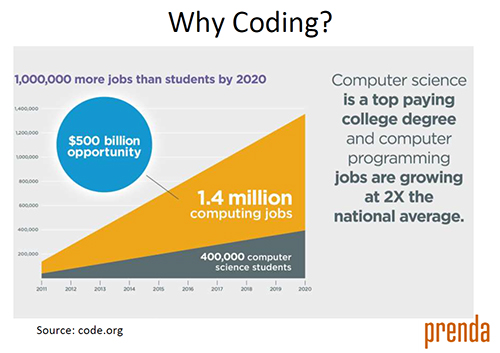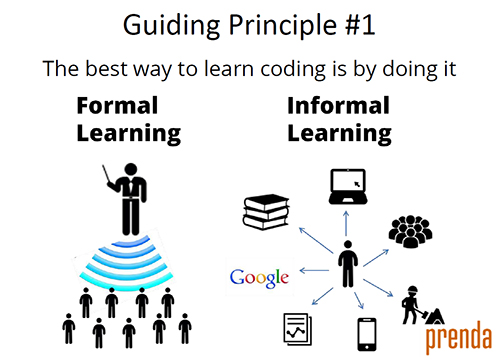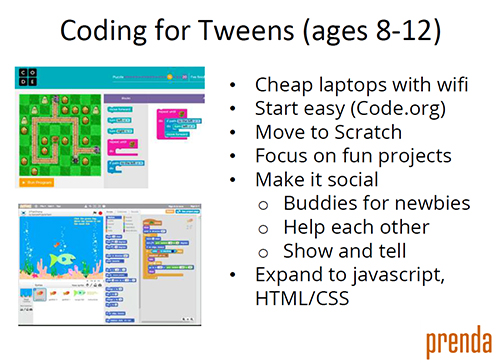No Experience Required: Coding for Everyone Webinar Write-up
 Last month, Kelly Smith, founder of Fiero Code, led the webinar Coding for Everyone: How Your Library Can Help Anyone Learn to Code, which introduced coding as an increasingly important digital literacy skill, showed why coding is important for all ages, and presented approaches and best practices by age along with a plethora of great resources.
Last month, Kelly Smith, founder of Fiero Code, led the webinar Coding for Everyone: How Your Library Can Help Anyone Learn to Code, which introduced coding as an increasingly important digital literacy skill, showed why coding is important for all ages, and presented approaches and best practices by age along with a plethora of great resources.
Smith began by introducing himself and his journey to coding in the library, "I'm a self-proclaimed technology nerd. I've always loved technology, it goes all the way back to being a child."
After selling his software company and moved back to his home town of Mesa, AZ, he noticed there wasn't a strong tech presence in the community and decided to do something about it. He approached the local library and began volunteering as the facilitator of a once-a-week kids coding club. The program started with 15 kids in a small computer lab and has since expanded (thanks in part to a crowd-funding effort) to include an additional programming room, a cart of Chromebook computers, and as many as 60 kids.
"The big breakthrough for me was realizing that you don’t need the tech expertise," says Smith. "And, in fact, you don't need to spend a ton of time preparing something because the kids can guide the learning."
 Webinar participants were encouraged to send programs and ideas they have tried in chat; many responding that they have tried Hour of Code, used the program Scratch, and others have held teen code academies and code clubs.
Webinar participants were encouraged to send programs and ideas they have tried in chat; many responding that they have tried Hour of Code, used the program Scratch, and others have held teen code academies and code clubs.
Smith shared why coding is so important—no matter what your age—including the fact that jobs that will require people who are computer programmers are far outpacing the actual number of computer science majors (see chart). He says, "Learning to program computers is as close as it gets in 2016 to a guaranteed job."
He also iterated why coding is important in libraries, a refrain of the literacy and accessibility anthem we all know by heart: community resource, digital literacy, free for all, 21st century learning with no obstacles between learner and information.
Smith also shared his three guiding principles:
1. The best way to learn coding is by doing it. (Never lecture, and that applies to all levels and ages.)
 2. Anyone can go online and teach themselves coding for free. (But most people won't. While there are so many free resources, people need help curating the information.)
2. Anyone can go online and teach themselves coding for free. (But most people won't. While there are so many free resources, people need help curating the information.)
3. Librarians have all the right skills to run a coding program. (Librarians have the optimism that answers exist and with some effort we can find the answer. And that's the perfect approach to learning coding.)
Ultimately, Smith says, the hybrid learning model of traditional classroom and online learning is the best combination for coding at libraries. He recommends regular in-person meetings, with one to two coders per computer, and 15 to 20 coders per facilitator. With an emphasis on projects and heavy peer interaction, the result is boisterous, interactive and effective learning. (For a peek at what a code club looks and sounds like, check out this great little video.)
Next Smith went through recommendations for technology and format by the age groups Pre-Readers (3-7), Tweens (8-12), Teens (13-18), Young Adults and Older Adults. Watch the webinar recording to get the details on each of these age group recommendations.
He also covered four things you’ll need if you're ready to start a code club:
Space. Find a place in your library where coders can be loud and creative.
Facilitators. Find a sponsor and some backup, people that feel comfortable with people and can be there every week. No coding expertise required!
Computers. You can ask people to bring laptops from home, but you will likely find a lot that need to borrow a computer. Any type of computer works, as long as it connects to the web.
Day and Time. Weekly meetings are best. Consistency is key!
The webinar packed in a lot of recommendations and resources (see below for links), and Smith provided additional Q&A after the webinar, which is also included below. For more on starting a coding program at your library, watch the webinar recording free, and ready to watch whenever you are.
 Post webinar Q&A:
Post webinar Q&A:
Participant: What would you recommend to help ages 8-12 learn javascript, HTML/CSS?
Smith: A lot of these kids will stick with Scratch for a while, so introduce javascript activities as a contest, or with a prize, OR for them to explore on their phones. Bitsbox and App Lab (does request that kids are 13+ to use) can be downloaded to your phone. Khan Academy has a Javascript curriculum. Much of this info is in the Code Club Resource Kit (pdf)
Participant: What software to create phone apps?
Smith: Bitsbox and App Lab are best starter ones. PhoneGap for teens and adults, designed to write code and then it ports it to Android/iOS. Also Thunkable. Apple just launching Swift Playgrounds, for learning to code using Swift which is new coding language for iPhone apps.
Participant: Do you feel teens can start at the levels you have listed in their age group even if they don't have the foundational experiences you list for the younger kids?
Smith: No, actually it's better to ramp them up starting with the earlier tools, but note that they'll move more quickly through it. Codecademy and Free Code Camp have more age-appropriate materials for older beginners.
Participant: How do you facilitate a program when you don't have the knowledge to answer the kids' questions?
Smith: The biggest thing is your mindset. If you frame it such that you can always help them find the answer (like we do in library reference work!), you've got what you need. You can remind them that you are not a teacher . . . you're learning with them!
Participant: We are in process to start a girls who code club—pros and cons?
Smith shared that he chose not to create a girls club, because he had both boys and girls interested, and he wanted to be sure that everyone who was interested was welcome. BUT if you do think there are girls that are uncomfortable, you can try girls only. He finds that girls are often more engaged in the clubs he works with.
Related Resources:
- Fiero Code
- Code Club Resource Kit (pdf)
- What is Code Club video (see Code Club in action)
- Scratch and Scratch Jr
- Tynker
- Code.org
- Udacity Nanodegree Programs
- Thinkful Mentors
- Code Louisville
- NYPL Tech Connect and Project code
- Codecademy teaching resources
- Learning Circles (see WebJunction webinar)
- Sugata Mitra's TED talks
- Arizona Code Challenge
- Additional coding information:
- Nebraska Library Commission Children & Youth Coding Resources
- TechSoup for Libraries Host a Coding Class at Your Library: Resources and Tools
- Google CS First Clubs (Queens Library example)
- WebJunction article on Chattanooga Public Library, DEV DEV: A Summer of Code
- Upcoming LITA Forum Preconference with Kelly
- Shared in chat:
- nclab.com
- ozobot.com
- Abbey Colucci, webinar participant, created: Apps & Websites to helping kids (& adults!) learn to code
- Information on growth mindset
- To find out more about jobs that might include coding, or other types of jobs, check out Dictionary of Occupational Titles
